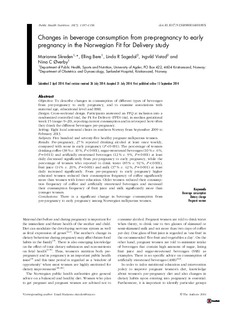Changes in beverage consumption from pre-pregnancy to early pregnancy in the Norwegian Fit for Delivery study
Journal article, Peer reviewed
Published version
Permanent lenke
http://hdl.handle.net/11250/2478101Utgivelsesdato
2015Metadata
Vis full innførselSamlinger
Sammendrag
Objective: To describe changes in consumption of different types of beverages from pre-pregnancy to early pregnancy, and to examine associations with maternal age, educational level and BMI.
Design: Cross-sectional design. Participants answered an FFQ at inclusion into a randomized controlled trial, the Fit for Delivery (FFD) trial, in median gestational week 15 (range: 9–20), reporting current consumption and in retrospect how often they drank the different beverages pre-pregnancy.
Setting: Eight local antenatal clinics in southern Norway from September 2009 to February 2013.
Subjects: Five hundred and seventy-five healthy pregnant nulliparous women. Results: Pre-pregnancy, 27% reported drinking alcohol at least once weekly, compared with none in early pregnancy (P<0·001). The percentage of women drinking coffee (38 % v. 10 %, P < 0·001), sugar-sweetened beverages (10 % v. 6 %, P=0·011) and artificially sweetened beverages (12% v. 9%, P=0·001) at least daily decreased significantly from pre-pregnancy to early pregnancy, while the percentage of women who reported to drink water (85% v. 92%, P<0·001), fruit juice (14% v. 20%, P=0·001) and milk (37% v. 42%, P=0·001) at least daily increased significantly. From pre-pregnancy to early pregnancy higher educated women reduced their consumption frequency of coffee significantly more than women with lower education. Older women reduced their consump- tion frequency of coffee and artificially sweetened beverages and increased their consumption frequency of fruit juice and milk significantly more than younger women.
Conclusions: There is a significant change in beverage consumption from pre-pregnancy to early pregnancy among Norwegian nulliparous women.
Keywords
Beverage consumption Dietary change Pregnant women
